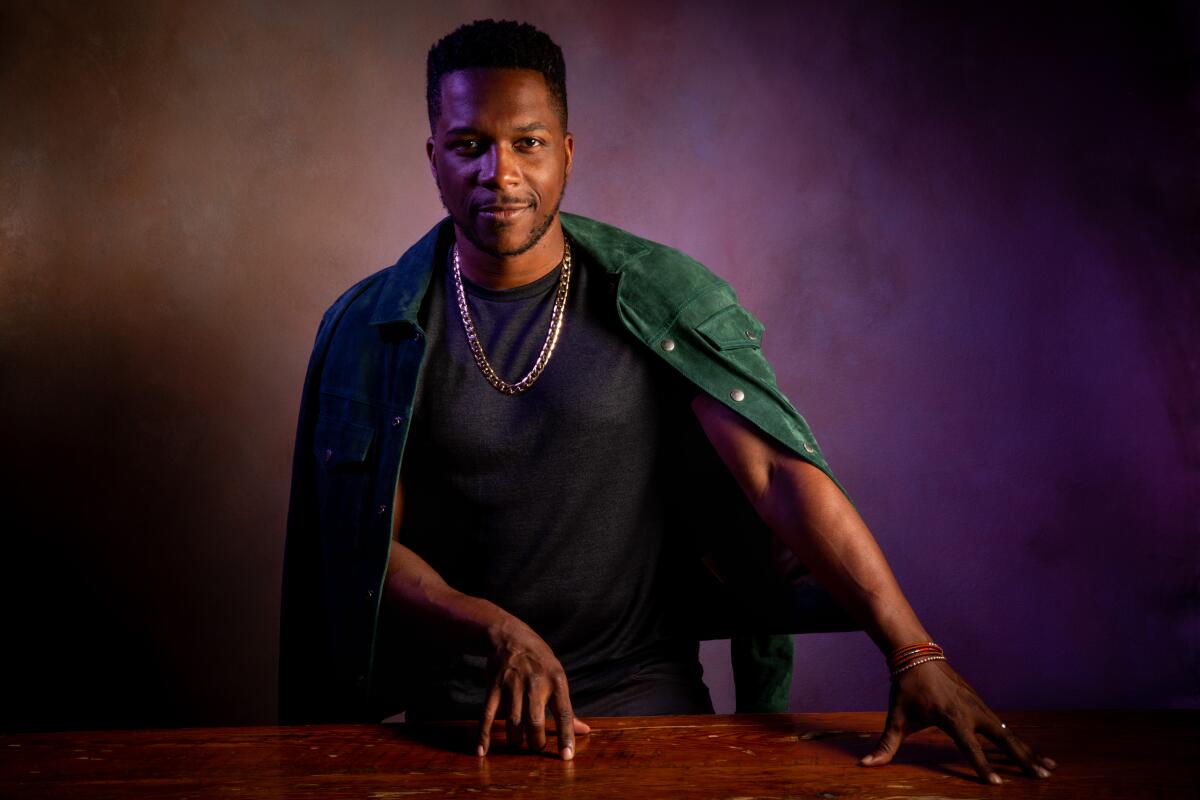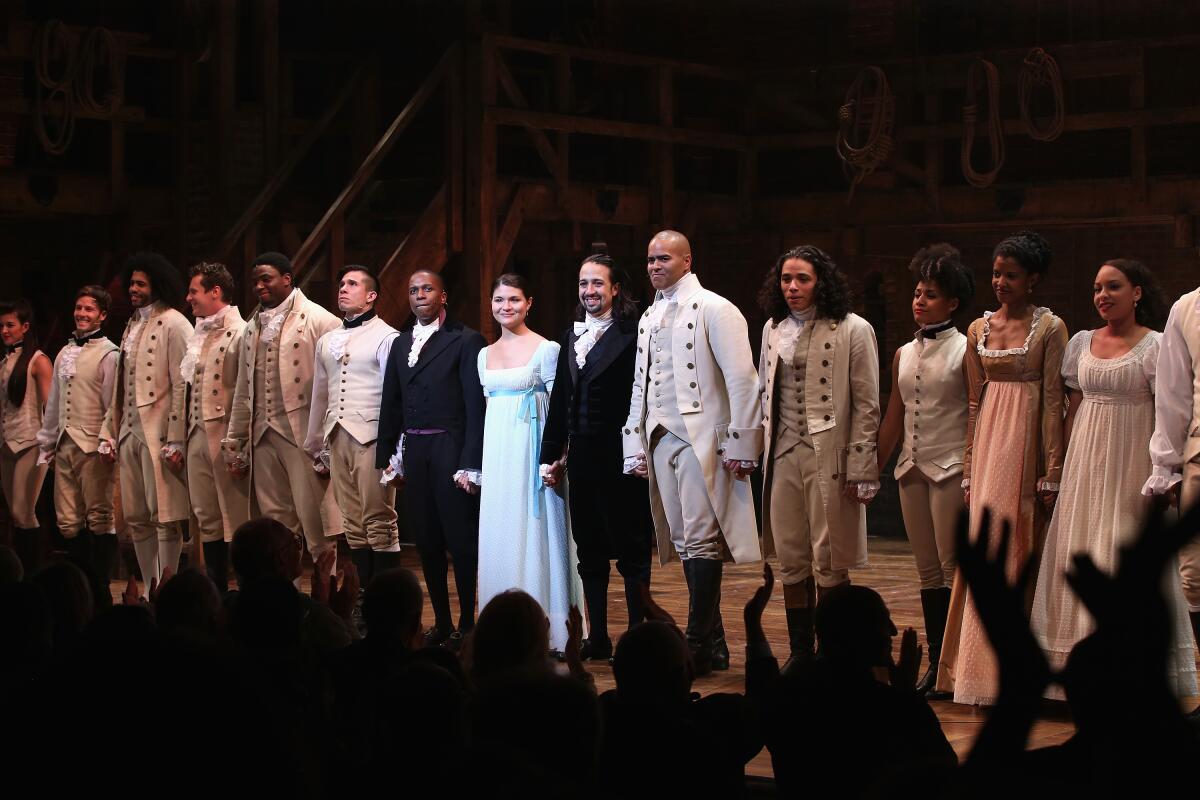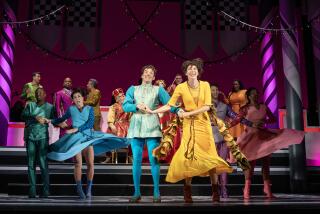‘We need to talk about the money’: Leslie Odom Jr.’s ‘Hamilton’ duels, onstage and off

- Share via
Eight times a week, for a solid year, Leslie Odom Jr. battled it out on Broadway with “Hamilton” composer and star Lin-Manuel Miranda. Odom ended up with the lead actor Tony for his work as the blockbuster musical’s narrator and nemesis, Aaron Burr. Their onstage duel, filmed in 2016, had been scheduled to hit theaters next year but will now be released on Disney+ on July 3.
Behind the scenes, the actor was on the front line of the fight to get the original cast — the majority of whom are Black and people of color — properly compensated for their pivotal work in the show’s development. Because as much as “Hamilton” tells the origin story of America, it also charts the challenges of building a lasting legacy in this country and securing a future for the generations after you. Surprise: The stage show about the first U.S. secretary of the Treasury is, in essence, about money.
For the record:
11:01 a.m. June 27, 2020This article misstates the frequency of Lin-Manuel Miranda’s appearances in “Hamilton” as eight times a week. He appeared in the production seven times a week.
Ahead of the Disney+ debut, Odom — who also starred opposite Cynthia Erivo in last year’s biopic “Harriet” and is social distancing with his wife, actress Nicolette Robinson, and daughter in Los Angeles — spoke frankly with The Times about helping to create the villain he played, fighting racism in the theater industry and getting into the room where it really happens: profit-sharing.
Many will discover “Hamilton” for the first time on Friday. How did your “Hamilton” journey begin?
It starts with a black box theater at Vassar College. Nicolette was there in 2013, working on a new work, and I’d visit her every weekend. The people behind [Miranda’s previous musical] “In the Heights” were doing a reading too, but there were no tickets left — before “Hamilton” was a thing, it was already the hottest ticket in Poughkeepsie!
I had made friends with the ushers — those are my people, I ushered all through college — and one of them made sure I got the very last folding chair in the very last row.
What was your first impression of the material?
Ten seconds in, I thought, “This thing is the boldest, precious, most literate thing I’ve ever experienced, and I’m going to bring everybody in my life to see it when it’s up.” I thought that as an audience member; I was not, in a million years, thinking I was going to be in the show. But three months later, I got an email from Lin asking me to be part of a reading.
With these things, there’s no guarantee you’ll be invited back; it’s literally just learning the music and singing it so the writer can hear it. But I was very aware that Burr was the role of a lifetime in maybe a once-in-a-generation type show, and that this was my shot, my chance to make my case for why I’d be a great Burr and why they needed to look no further. I did those readings and workshops over about a year and a half before I ever had a contract to be a part of the show.
The Tony-winning stage sensation “Hamilton” is available for home viewing on Disney+. Director Thomas Kail details the process of preserving the original Broadway production on screen.
Which song is your favorite, for whatever reason?
“Wait for It” ministered to me during those workshops, when I didn’t know if in the end they’d replace me for whatever reason, or whether I’d get another job that made it so I couldn’t do the show. I’m giving this show everything I have with no guarantee that a commitment waits for me at the end of it.
There was also a chance to go to Broadway in the season before we did. As wonderful as it was for the show to keep getting extended at the Public Theater, we ended up being off-Broadway for six months, and I remember how difficult that was for a lot of us. All Broadway really means is a livable wage, with the Broadway minimum. At the Public, I sang “Wait for It” every night and went home with my $400 a week — as a married man in New York City, it ain’t easy.
I let that song work on my heart: “OK, we’re not going to Broadway this year, we don’t know when we’re going to Broadway, or if.” To have the show then open on Broadway on my birthday in 2015 felt like a cosmic wink, like I was being rewarded for staying the course.
Burr is a complex role that many actors have since played. What’s unique about your take?
Lin wrote with such complexity that the delicious experience of watching it, it’s about them and, it’s also about us. There’s moments it’s about [America’s Founding Fathers] and then there’s the boldness of watching Lin and Daveed say, “Immigrants, we get the job done!”
I imbued the relationship between Burr and Hamilton with all of the love and respect that I have for Lin-Manuel. When Burr marvels at Hamilton’s brilliance, I’m marveling at Lin’s accomplishment. [Biographer] Ron Chernow makes that case in the book: These guys were friends. They rolled in the same circle for decades; they had disagreements and different approaches, but they also worked together quite a bit. There was a real relationship there.
Burr is introduced as “the damn fool who shot” Hamilton. How did that inevitability drive your performance?
Early on, I thought, for lack of a better analogy, how interesting would it be to show a newlywed couple a snapshot of the day they decided to get a divorce. They wouldn’t even believe it. What could have happened? Was it one moment? Did it dissolve over time?
I always imagined Burr in some space neither here nor there, where he has to work out this mistake in his life, to learn whatever he’s supposed to learn. That is his purgatory. “Maybe I can make it turn out differently tonight; if I make some different choices, if I’m kind enough in the right places, it doesn’t have to end that way.”
And of course it does, because that’s the nature of tragedy in theater. When a production of “Romeo and Juliet” is done right, the last thing in the world we should think is that those young lovers won’t end up together, because we lose ourselves in the story and we take the ride every time.
He’s a “villain” who is ultimately humanized by the end.
Exactly. A lawyer friend of mine gave me a thought that I hung a lot of the performance on: “So much of my career is spent defending people who are being judged for their worst act on their worst day.” The reality of that pain and regret gave me compassion for the guy.
And if we’re being honest, I think there’s a lot more people out there in the audience who are closer to Burr than Hamilton. They’re hard workers, they love their family, they want to do great things, but they also want to take it easy. They don’t have a relentless drive and genius and passion for anything in particular. All I had to do was tell the truth about that experience: that jealousy, that envy, that admiration. Every performance ran me out — I’d lay out on the floor afterward, have my tea or my glass of whiskey — but hopefully I had won their empathy and gotten them to understand why he did the things he did.
Sure, Lin-Manuel Miranda’s ‘Hamilton’ was a massive box office success worldwide, but still, many people will see it for the first time on Disney+.
What excites you most about your performance being preserved on film?
To be able to share this with my 3-year-old daughter who wasn’t even born when I was doing this show, that’s meaningful. I want to say this in a way that doesn’t trivialize it: It’s a struggle to find the films and books and images in the media that reflect her in the way that I and her mother see her, as beautiful and capable and a star of her own narrative. Not in entertainment — I’m trying to raise a doctor, believe me! — but I mean that Black kids don’t often get to be the center of their own stories. A lot of times, it’s only through watching little white kids have experiences and imagining themselves in those shoes. Sometimes, things get lost in translation and we end up with these layers of self-loathing and self-hatred.
I thank [director Thomas Kail] for ushering, with such care, these images of Black and brown beauty into the world. It means a lot to me as a dad, and I know that it’s gonna mean a lot for young people to see themselves mirrored back in Renée [Elise Goldsberry], Jasmine [Cephas Jones], Lin, Daveed [Diggs], Oak [Onaodowan], Anthony [Ramos], everyone — they all look so damn good, and that matters. It is still a political statement to just put beautiful images of Black and brown people out into the world, and it is necessary.

What came to mind while watching the original Broadway cast onscreen for the first time?
I was reminded of the work it took to get that thing up on its feet, which is the hardest part of theater. It was a near-perfect collaboration across the board. You don’t get to see Andy Blankenbuehler’s choreography or Tommy Kail’s direction or Howell Binkley’s lighting design on the cast album.
Everybody touched this thing and prayed for it and gave it their best because we thought it was worthy. I watched the movie and thought, look at this magnificent thing we made together. Look at what can happen when these rooms look a lot more like our communities and our world. Look at what can happen when the table gets bigger, when the room expands and more people are invited to the party.
If you’re organizing around a table and everybody looks like you, everybody comes from where you come from, everybody has the same perspective as you, no way can you be as magnificent as this thing we created. That’s the stuff I’m trying to be a part of, things like “Hamilton” that are diverse, inclusive and collaborative.
Just before this was filmed, you helped make sure that actors’ contracts included profit-sharing and financial protections for whatever this footage would become. Why did you speak up?
I’ll say this: white supremacy is upheld by systems, and it seems like we’re really understanding that for the first time in this country. Along with the educational system, the medical system and the police departments, entertainment is one of those goddamn systems. We need to talk about racism and white supremacy in theater. We need to talk about the money.
This is about the economic ways that Black people and people of color and women are remunerated for our contributions. What is our ongoing relationship to the companies and institutions we help build with our time and our talents? Everybody should be at that table in the same way that everybody was at that table to create it. Everybody needs to be a part of the feeding when the food’s being doled out.
We need to stop being polite and talk about the money part of it too. You want to be an ally? You make sure that Black people and people of color and women are getting paid, that they’ll be able to take money home to their families. It’s not about revenge, it’s about equality.
These stipulations are present in the film and TV industries, but not so much theater.
Generally, in the theater, if you’re not part of the profit-sharing, and once your knees give out or your back gives out and you’re not part of the show anymore — even if you are a part of helping to create it, whatever small part you played in helping to make the thing — there’s no way you’re financially tied to this show.
That never sat well with me, it never seemed fair. I spent the first decade of my career almost working solely in television. I’d shoot an episode of “CSI: Miami,” I’d get paid. Six months later when I wasn’t working, I’d get $1,000 in my mailbox. That residual income — we’d call it “mailbox money” — was life-sustaining. It was like life support.
With our company and shows that have come after us, the rules of development are changing. I’m very pleased about that because even though I wasn’t really doing anything particularly amazing before “Hamilton,” that “mailbox money” got me through my 20s and got me to the place where I was able to make a real contribution to society. So we want to support these young artists as they’re on their way to making things that could have real lasting cultural impact.
Years from now, long after we’re gone and “Hamilton” remains, what do you hope viewers get out of watching this movie?
Well, number one, I want you to check in on my daughter and my daughter’s daughter and make sure they’re getting paid for it, you know what I’m saying? We’re doing this to lift up our family lines! That was one of the things we were in there fighting for: that our kids and our grandkids would have a piece of any future success.
I’ll also say that, with every tragedy that’s ever been written, there are things we’re supposed to see and learn to make changes in our own lives. You ain’t trying to be Aaron Burr, are you? You’re trying to be Alexander Hamilton, but are you really trying to die like that? Take the good and let it inspire you, and take the horror and let it change you.
I know entertainment has its place — it’s apparently the most nonessential job in the country right now — but the real power of theater is it’s also a clinic and a pulpit. We cannot abandon the responsibility of the theater in favor of commerce and capitalism; we can’t turn over all of our Broadway houses to movie musicals, however fantastic they may be. If we don’t give audiences a place for their catharsis and healing in the theater, they will work it out in real life in ways that can have real detrimental effects on us as a society.
More to Read
Only good movies
Get the Indie Focus newsletter, Mark Olsen's weekly guide to the world of cinema.
You may occasionally receive promotional content from the Los Angeles Times.











